In today’s e-commerce landscape, returns have become a huge deal.
Recent research shows that the e-commerce return rate, which was 16% in 2022, now falls around somewhere between 20-30%.
Just like choosing what they want to buy, customers have been showing increasing involvement in sending it back (be it for any reason).
This has made how returns are handled at e-commerce stores a huge differentiator when it comes to customers choosing brands. 92% of shoppers say they will buy again if the return process is easy.
But you don’t have to stress your mind too much about this — the criterion is very simple.
When customers buy something online and it doesn’t work out, sending it back shouldn’t be a headache.
Easier said than done, navigating through returns might be difficult for e-commerce merchants but there’s a catch to it. Meet customers’ high expectations and you can treat yourself with loyal customers for life.
This is where a Returns Experience Management solution comes into play. We’ll cover how it redefines returns as a growth driver for your business. But first, we’ll cover some basics to help you understand better.
What is Returns Experience Management?
E-commerce returns from a business’ PoV aren’t just collecting the shipped-out product back and taking further steps to rectify the issue. It’s filled with multiple KPIs such as return rate and return spend that must be tracked and optimized regularly in order to measure true success when it comes to order returns.
Returns Experience Management (REM) is the strategies and practices that e-commerce businesses implement to effectively handle and optimize customer experience when dealing with product returns.
REM encompasses various elements of the returns process such as Returns policy, status tracking, analytics, and much more aimed at making the returns process as smooth as possible for customers while also ensuring that the business can manage returns efficiently.
However, not all e-commerce businesses see returns the same way their customers expect them to. But we can’t blame them for it. There are a lot of misconceptions about returns that make e-commerce merchants repel them.
This unfortunately results in a situation where customers’ returns experience suffers tremendously leading to irreparable problems and lost opportunities.
Here are some insights into the current state of e-commerce returns and how businesses, particularly different teams of a store are affected by them.
The Current State Of Returns In E-Commerce - An Insight
As customers, e-commerce returns are all about sending back an order that we collect. What follows next falls under totally different aspects like refunds and replacements. It is the experience that matters during the moments of the returns process.
But things aren’t the same for e-commerce businesses. In order to provide THAT experience, there is a chain of activities where a lot of teams come together and perform exhaustive tasks that could impact the success of the business in the long run.
One wrong move and that will be the last the business hears from the customer again. This is where REM comes in to boost return-related metrics that matter most to your business.
To get a better context into what REM can do for your business, let’s take a look at how returns work in the back end of an environment that doesn’t have a REM in place.
1. Dealing with frequent returns inquiries is a tedious process
- Customers need to contact the support team to return or exchange products and again to learn about the status of their returns and refunds – making the process time-consuming and unmanageable
- If not for frequent customer interaction, there is often a lack of clarity in shipping instructions further adds to the confusion in returning products
2. An influx of inquiries from anxious customers bombarding support teams
- Little to no visibility into the status of the return and lack of quick accessibility to real-time information make prompt support and resolution a hassle.
- Repetitive inquiries from concerned customers about the status of their returns and refunds lead to delayed response
- Customers are unable to easily look up the status of their return at their own discretion, leading to anxiety and frustration
3. Unmanaged returns are a cost center for e-commerce businesses
- Customers opt for refunds due to the complicated exchange process, leading to losing a sale.
- Customers often do not purchase again after receiving refunds to their original payment method, resulting in a lost sale and extra shipping costs
4. Manually processing returns makes it difficult to handle operations
- Difficult to validate and record return information shared by customers via email communications. Customers also do not comply with the return policy and return items that are ineligible for returns
- Manually generating shipping labels from the shipping carrier’s website, emailing or physically mailing them to customers each time a return is initiated as time-consuming and labor-intensive
- Hassle to effectively track returns by warehouse operators and the operations team, etc
5. There is a clear lack of insight into the returns process
- Lack of visibility into factors leading to returns such as operations and inefficiencies
- Lack of opportunity to maintain accurate return inventory records such as timesheets or data to monitor and optimize time spent on return operations
- Lack of visibility into customer’s return experience
Not to worry! The good news is that Returns Experience Management (REM) has a host of use cases for a variety of organizational roles that can help you resolve the issues we’ve discussed.
Use Cases For A Returns Experience Management Solution
1. Offer shoppers a simple and seamless return experience
Operations & Marketing teams have forever struggled to deal with customers, who feel the returns process is difficult, time-consuming, and frustrating.
With no REM in place, customers have the need to contact the support team whenever there’s a need to return or exchange products. More often than not, this frustrates customers who are already irate over having to return something that they’ve longed enough to buy (all the more pressure for merchants during times like the holiday season when gifts hold higher emotional value).
The solution is really simple: your customers are not looking forward to doing returns, so why make the process even more frustrating for them?
With a REM in place, you make returns and exchanges self-service to shoppers, via a dedicated returns portal that enables easy initiation and automated label generation, thereby eliminating the need for customers to the support team each time.
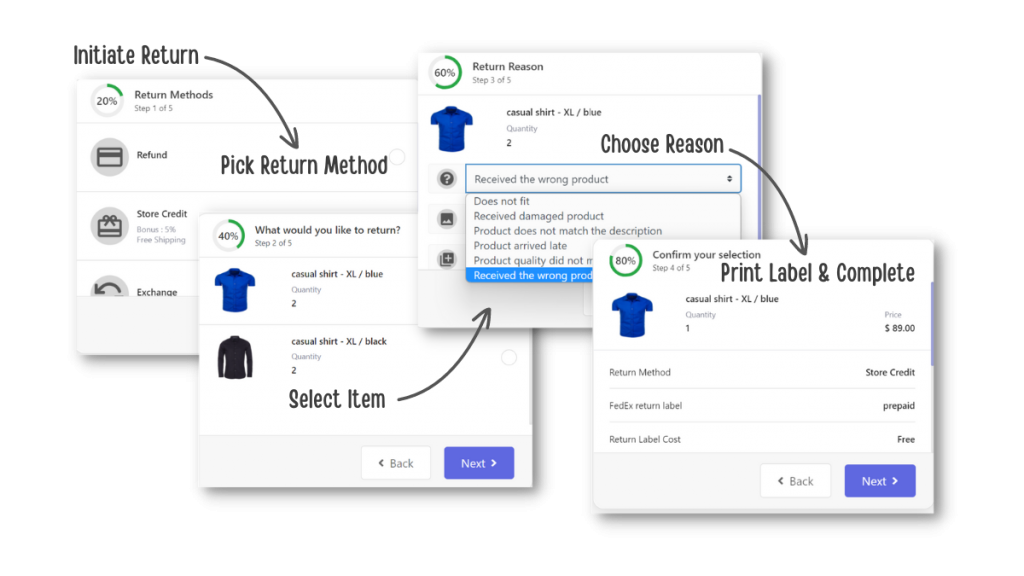
2. Reduce inquiries from anxious customers about the status of their returns and refunds.
Customer support teams are bombarded with an influx of inquiries from concerned customers about the status of their returns and refunds.
Just like the order delivery process, customers expect the business to stay in the know of their return’s status at all times and become increasingly anxious when they’re left in the dark regarding it.
In normal cases, this affects the returns experience of the customers by making them constantly go to the shipping carrier’s website to check the return status. In extreme cases, this can lead to anxious customers bombarding your support team with a return status inquiry that can consume all of their time.
Here’s the solution. REM helps businesses send automated return status updates to customers with the ability to track their returns in real time. By mitigating customers’ anxiety via regular and timely engagement, businesses can reduce return-related customer inquiries by up to 80%.
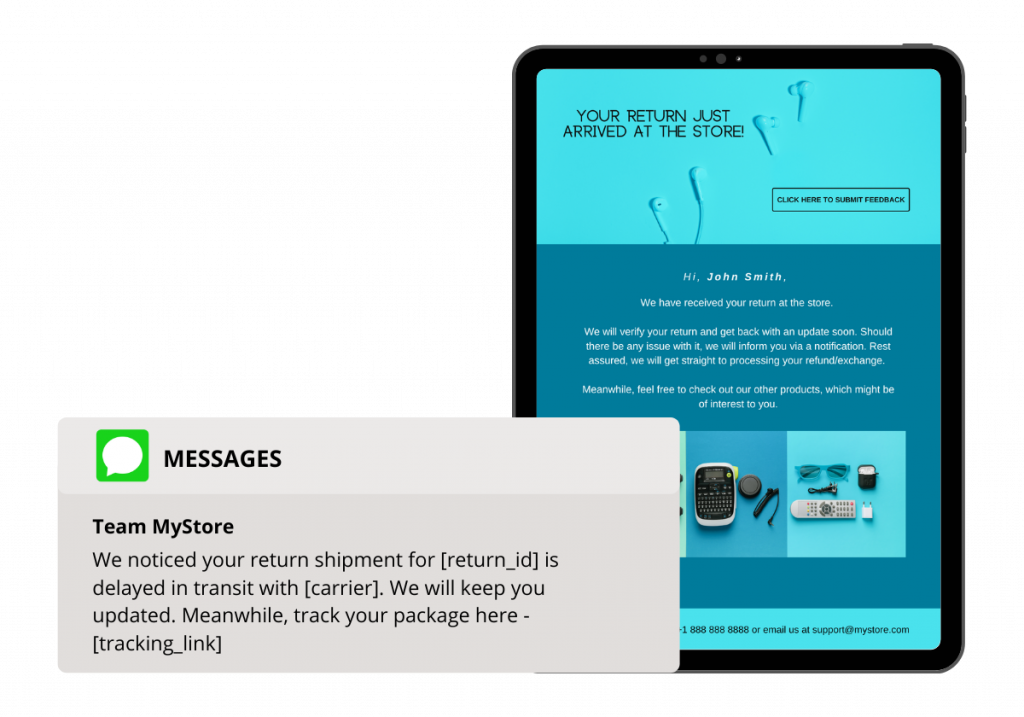
3. Retain sales and revenue with returns
In a typical environment, returns typically result in refunds, hence losing sales and profits.
According to a recent report, 70% of all returns are size and fit related. That’s almost three-fourths of your returns that don’t have to mean a refund.
However, with a lack of REM in place, Returns typically result in refunds, where the business has to refund the customer for the the purchase price of the product, as well as the cost of shipping the product back to the business. In addition, the business may have to pay a restocking fee, which is a fee that is charged to customers who return products.
Instead of refunding every return, REM provides businesses the chance to get smart with returns via flexible return methods.
By offering seamless exchange and store credit options, businesses can:
- Keep customers shopping with the business despite an order return in place
- Provide a great returns experience and ensure that customers are more likely to spend more money with the business
- Reduce return-associated costs such as refunds and other processing costs and retain revenue from over 30% of your returns
To ensure that this process yields more successful results, businesses can also incentivize customers to opt for exchange or store credit with prepaid labels, free shipping, and bonus credit.
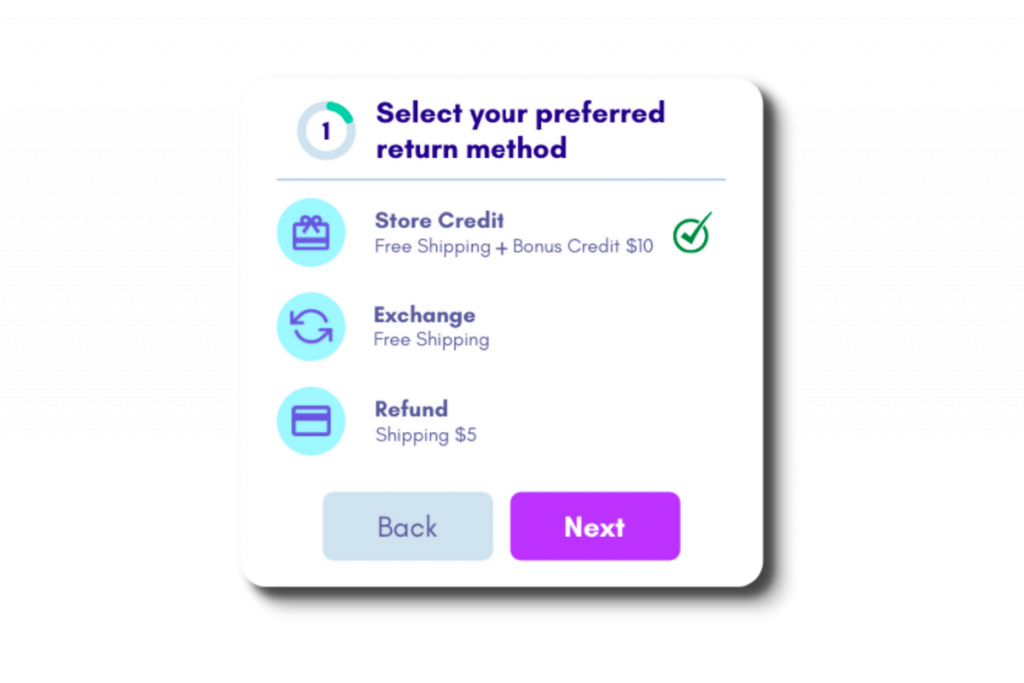
4. Automate and streamline the return process to reduce operational time
Return processes that heavily rely on assistance from support teams make returns unmanageable and time-consuming.
It’s not just initiation, customers’ doubts about returns begin the moment they have a return requirement and repeatedly check the returns page to understand more about the company’s policies with returns.
One of the main reasons for this happening is because the returns get handled differ brand to brand and when things are unclear, customers do have a hard time understanding if their product does qualify for a return. This often leads to the need for human intervention at every step which creates a bottleneck by straining resources and frustrating customers who expect quick and efficient resolutions.
This is where REM comes in to help businesses transform their return experience by automating the return process via presetting and customizing return rules and policies, auto-generating return labels, etc, and ultimately reducing return processing time by up to 90%.
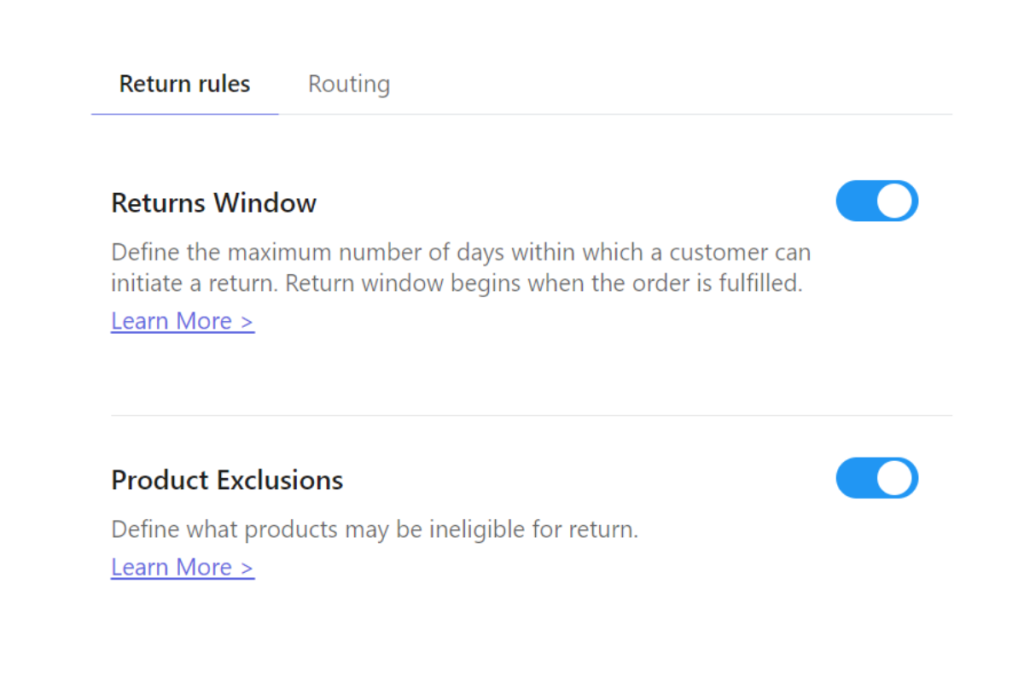
5. Gain visibility into the when, the where, and the how the return progresses
Warehouse operators and the operations team are unable to effectively track returns in real time, making it a hassle to maintain accurate return inventory records and streamline the overall returns process.
Most businesses view returns as something complicated because they lack sufficient insights into what’s going wrong in the first place, thereby having no room to make necessary improvements and streamline the overall returns process.
Returns Experience Management, built to boost return-related metrics that matter most to businesses, comes with the ability to break down returns in order to gain visibility into the exact status, condition, and location of every return, i.e. anything related to the product being returned.
By breaking down returns into simple, actionable metrics, businesses can easily keep track, make better business decisions to turn these metrics work in your favor, and ultimately spell the success of your e-commerce business’ returns strategies.
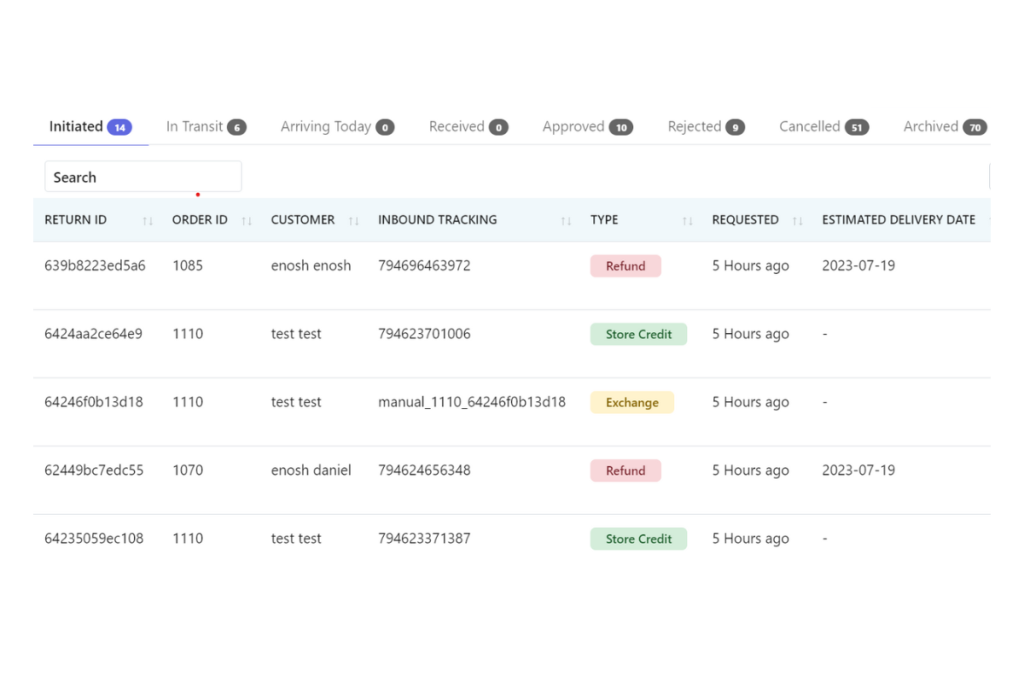
6. Optimize return operations and drive strategic process improvements with actionable insights into returns
There is a lack of true visibility into their return operations and inefficiencies to make necessary improvements.
Under normal circumstances, handling multiple returns can really be overwhelming, particularly during times like peak shopping seasons.
Rather than going in blindly, it is better for businesses to get complete visibility into how your returns are performing via actionable insights, particularly through analyzing return trends, such as the types of products frequently returned, reasons for returns, etc, and identifying root causes to drive improvements to your returns process and experience.
For instance, if a specific product category consistently experiences high returns, the business can scrutinize its quality, sizing information, or imagery to address underlying issues. Armed with this data, companies can refine product descriptions, and enhance quality control.
Embracing these insights enables e-commerce businesses to gain absolute visibility & control to measure and optimize the entire return operations.

Lateshipment.Com’s Returns Experience Management To Redefine Returns As A Growth Driver For E-commerce Business
LateShipment.com’s Returns Experience Management (REM) platform helps e-commerce businesses take delight beyond the buy button with seamless, flexible returns in the form of:
- Provisions to set up flexible return methods and automated, prepaid labels
- A customizable, on-demand return portal with zero interaction with support agents to make the return experience fast and easy for customers
- Proactive updates on return requests, via automated email and SMS status notifications, keep customers in the loop effortlessly
- A live tracking page to provide transparency around return status and eliminate customer anxiety about the whereabouts of their package
- Offer seamless exchange and store credit options to ensure revenue retention
- Support user and warehouse operator dashboards are purpose-built to drive quick return request resolution
- Proactive, automated status updates ensure your customers have complete transparency on return status at all times, thereby reducing ticket volume
- Returns trend analysis and insights such as return satisfaction scores to keep track and make constant improvements to provide the best return experience there is
And boost returns-related metrics that matter most to your business via increasing conversion rate, repeat purchases, revenue retained, etc, and reduce time spent per return.
By using REM, e-commerce businesses can improve the returns process and increase customer satisfaction, leading to improved customer loyalty, increased sales, and ultimately a better bottom line.
If you are an e-commerce merchant looking to integrate Returns Experience Management into your existing business process, our experts are here to talk to you about the best ways REM can work for your business.



